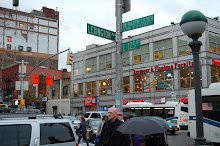Friday March 26
This was the second time I have attended Eddie Prevost's weekly workshop, the first having been two weeks before on 12th March. If I continue to attend, as is likely, a blog seems to be the ideal format in which to record the experience. That was one of my main reasons for starting this blog.
So, let's start with some background. I play alto saxophone and have done for over twenty-five years, although in that time I've not played much with other people. This used to be because in my head I wanted to sound like Lee Konitz but in my heart I knew I didn't. For a period in the nineties, I attended evening lessons at which I participated in a saxophone quartet. Eventually - my children were young then - I dropped out due to lack of time, not inclination. When my daughter Hannah was in her teens, she took over my sax for several years and attended weekly lessons. Gallingly, she could soon play better than I could!
In 2006, a good friend and colleague Lester Moses (himself an experienced and accomplished player of tenor and soprano saxophones who has had his own band - Moses and the Tablets! - and played at events such as John Bisset's Relay) tried to get me involved in Andy Sheppard's 200 saxophone spectacular that opened that year's London Jazz Festival. As this coincided with my sax still being under the effective control of Hannah, I didn't get it together to practise the parts and so didn't take part. When I attended the event as an audience member, I kicked myself that I hadn't; I wanted to be part of that.
In 2009, another opportunity arose and I took it - John Harle's Leviathan extravaganza that involved 800 saxophones and was part of the City of London Festival. (It featured 800 saxophones as it marked the 800th anniversary of the first stone London Bridge.) Repaying a favour, I sent details to Lester. This time, I did learn the parts and took part, loving every minute of the event. Playing with that many other saxophonists was thrilling.
As well as scored parts, including a unison grand finale on London Bridge conducted by John Harle, Leviathan had scope for free-blowing sections. In practising for these, I discovered I enjoyed it. I had finally got Lee Konitz out of my head. (No offence, Lee. I still adore your music and would love to interview you one day.)
As I was preparing for Leviathan, one evening at Cafe Oto I mentioned it in conversation with Daichi Yoshikawa. (Daichi works at Cafe Oto, one of London's best venues for live music. He is also a regular at the workshop, playing electronics.) His response was instant, "You ought to come to Eddie's workshop." That conversation and his suggestion set off a train of events that ended up on 12th March 2010....
To be continued...

